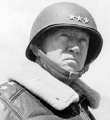12th Infantry Regiment (4th Inf. Div.)
West of Gey
By Captain Frederic N. Oettinger Jr.

INTRODUCTION
General George S. Patton Jr., in a letter to Major General Raymond O. Barton said in part: "So far as I know, no American division in France has excelled the magnificent record of the 4th Infantry Division, which has been almost continuously in action since it fought its way ashore on the 6th day of last June."
 General George S. Patton Jr. |
 Major General Raymond O. Barton |
"Your fight in the Hurtgen Forest was an epic of stark Infantry combat." 1
The fight in the Hurtgen forest, was action of the individual rifleman. The normal accompanying team of Artillery and Tanks was used infrequently in that the limiting terrain characteristics, consisting of deep ravines and steep ridges coupled with extremely limited visibility, made it impracticable, if not impossible, to use these allied arms.
This combat action is the account of Company "B", 12th Infantry Regiment, 4th Infantry Division, from 28 November 1944 to 5 December 1944, in its final notion to clear the Hurtgen Forest find to seize, organize and hold the high ground west of and overlooking the town of Gey, Germany. (See Map C)
On 6 June 1944, the 4th Infantry Division stormed the beaches of Normandy, landing at H-hour, D-day on Utah Beach. By 25 June, Cherbourg had been cleared by elements of the Division. Completing the Normandy Campaign on 24 July, the "Ivy" Division participated in the St. Lô breakthrough on 25 July to begin the Northern France Campaign, which lasted from 25 July to 14 September. During this phase, the Division participated in the mad dash across France. The Belgian border was crossed on 6 September 1944 and the Siegfried Line was first breached on the first day of the Rhineland Campaign which officially began on 15 September 1944. The 4th Division remained in Schnee Eifel Forest section of the Siegfried Line until 4 October 1944, when relief was effected by the 2nd Infantry Division. The Division then moved north to the vicinity of Bullingen, Belgium and remained in this quiet sector until 7 November 1944. 2
The jubilant days of August end September were gone; the war was not to be over in a matter of days. The pace of advance, instead of forty miles a day, was now measured in several hundreds of yards on an allotment of four or five rounds per artillery gun per day.
Commencing on 8 November 1944, near Zweifall, Germany, the 12th Infantry Regiment, a part, of the 4th Infantry Division, was given the mission of driving north and clearing a portion of the Hurtgen Forest in order to reach the Cologne plain. 3
This coming action of one month duration in the Hurtgen Forest gave the 4th Infantry Division three of its four Congressional Medals of Honor.

The Hurtgen Forest, covering approximately 50 square miles, was characterized by lofty evergreens, closely spaced and reaching into the sky to a height of almost 100 feet, thus screening the warming and light-giving rays of the sun. In addition, this area was void of a road net adequate to meet the logistical requirements of an Infantry Division. 4
The German Military had estimated this area to be an excellent defensive zone, in as much as the natural obstacle, in the form of the trees, which were wide in girth and full in foliage, gave a feeling of depression to all who ventured and stayed within their depths for even short periods of fighting. To make the area even more formidable, the Germans intensified their defensives in the form of artificial obstacles consisting of anti-personnel mines, wire, pillboxes, trench systems and covered bunkers.
This was a zone incorporated into their Siegfried Line fortifications. 5
General J. Lawton Collins, Commanding General of VII Corps said, "Combat in woods calls for top notch leadership on the part of small unit commanders and the highest order of individual courage. The drive of the 4th Infantry Division, across its sector of the Hurtgen Forest required a continuous display of those qualities under the most adverse conditions of terrain and weather." 6
The cold, dark month of November contributed substantially decreasing forward movements of Allied troops. The German fighting on his own "sacred soil" fought stubbornly, even fanatically for every yard. 7
The Battle of the Hurtgen Forest was characterized by units operating in heavy woods. This type of action called for increased demand in control in lower units. An added problem was the factor of distance between units. Contact was seldom achieved with units on the flanks. 8
There was a general lack of artillery supporting fires due to the difficulty of observed fires. Also, an artillery round would enter the target at an angle and this would very often cause the round to detonate prior to its arrival in the target area. This premature detonation would either cause casualties to friendly troops or would result in a wasted round. 9
The range of radios, organic to the Infantry Regiment, was decreased because of the dense woods. 10
Re-supply of rifle companies was a continuous problem. Many times decisions had to be made to determine that portion of the essential elements of supply to be sent forward to the Rifle Company. 11
The account of this combat action will bring forth various ways in which these difficulties were overcome, thus enabling Company "B" to accomplish its mission. 12

